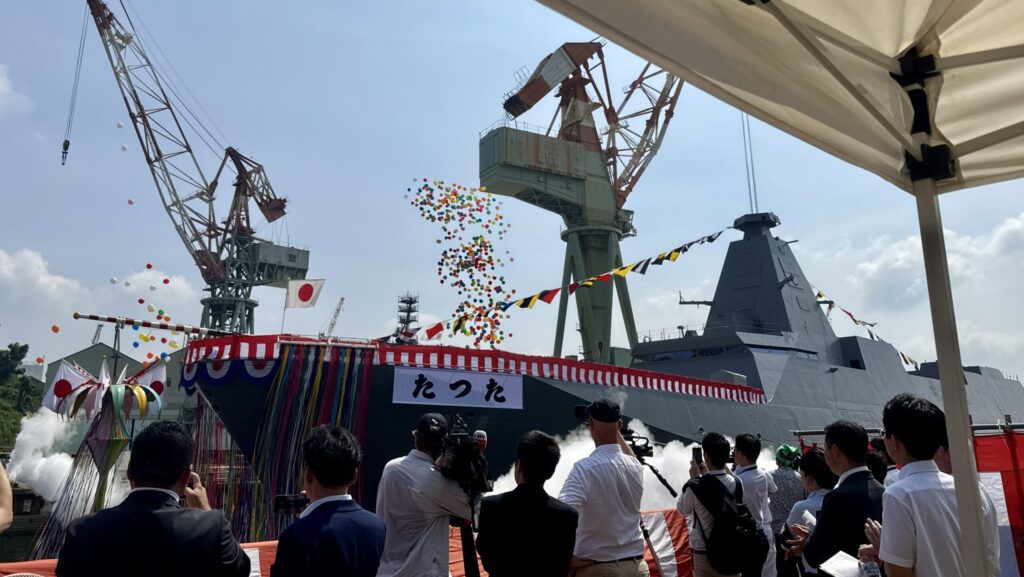
NAGASAKI — Japan has taken an unprecedented step in its efforts to make Australia the first international customer for its advanced Mogami-class frigate. The typically reserved Ministry of Defense has flown Australian-based reporters to Nagasaki this week to showcase the frigate’s capabilities, marking a rare move to bolster defense ties.
Over a three-day briefing, journalists were informed about the ship’s state-of-the-art systems and Japan’s strategic vision for a closer defense and industrial partnership with Australia. Mitsubishi Heavy Industries, the shipbuilder, has committed to sharing the program’s intellectual property and providing parts and support throughout the ship’s projected 40-year lifespan.
Strategic Diplomacy and Defense Ties
Japanese Defense Minister Gen Nakatani underscored the significance of this initiative by attending the launch and naming ceremony of the 11th ship in the Mogami class. In a personal touch, Nakatani presented his business card to each reporter, signaling Japan’s earnestness in securing this deal.
Should Australia proceed with the purchase, Nakatani assured that it would “increase sustainment and resilience” in the Indo-Pacific region. This sentiment was echoed by numerous industry and government officials, emphasizing an “all-Japan government approach” to demonstrate readiness and commitment to exporting a major weapon system for the first time since before World War II.
Competitive Landscape and Project Timeline
Japan is competing with Germany’s ThyssenKrupp Marine Systems (TKMS) to sell Australia 11 frigates, intended to replace the aging ANZAC-class ships. According to sources, the Australian Defense Force and Ministry of Defense are currently engaged in Comprehensive Risk Reduction with both companies. A pivotal decision by the National Security Council is anticipated this month, followed by an official Request For Tender. The final decision is expected by the end of the year, with the first ship’s delivery projected for 2029.
Australia’s requirements for the competition stipulate that the frigates must be available for purchase off-the-shelf. The Mogami offers an improved version with a 32-cell Vertical Launch System, doubling that of TKMS’s initial offer. Additionally, it features two diesel engines to power sophisticated systems, including Anti-Submarine Warfare, mine warfare, and advanced AESA radar and sensors.
Technological Advancements and Operational Efficiency
The Mogami’s advanced Combat Information Center (CIC) is a standout feature, allowing the captain to manage the ship with a crew of 10, although it can accommodate up to 30 officers. The CIC is located belowdecks and fortified with tank armor, a necessity for maintaining operational capability if the CIC is compromised.
The ship’s design also includes a reduced radar cross-section and stealth features, such as minimized infrared and electromagnetic signatures. The hull and superstructure’s bent angles resemble stealth aircraft, and the modular antenna system allows for quick replacements in battle-damaged scenarios.
Japan’s Commitment to Timely Delivery
Japanese officials highlighted Mitsubishi’s impeccable 35-year track record of on-time naval ship deliveries. Osamu Nishiwaki, a senior official at Japan’s Acquisition, Technology and Logistics Agency (ATLA), assured reporters of the government’s guarantee for timely project execution. “We can definitely guarantee the on-time delivery,” Nishiwaki affirmed, emphasizing Japan’s reliability.
“We the Japanese government will guarantee that the whole project, and all the contracts will go smoothly so that there will not be any delay to the project,” Nishiwaki said.
Mitsubishi currently delivers two Mogamis annually and plans to increase this to three, underscoring their production capacity and commitment to meeting deadlines.
Implications and Future Prospects
The strategic push to sell the Mogami frigates to Australia is part of Japan’s broader effort to enhance its defense exports and strengthen regional security alliances. The decision, expected by the end of the year, could significantly impact the defense landscape in the Indo-Pacific, bolstering both nations’ maritime capabilities.
As the deadline approaches, the outcome of this competition will not only shape the future of Japan-Australia defense relations but also set a precedent for Japan’s role in the global arms market. The Mogami frigate, with its advanced technology and strategic advantages, stands as a testament to Japan’s growing ambitions in defense exports.






